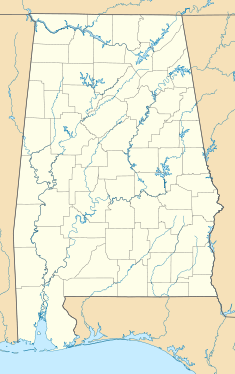- Dr. John R. Drish House
-
Dr. John R. Drish House Drish House in 2010, with stabilization measures underwayLocation: 2300 17th Street
Tuscaloosa, Alabama[1]Coordinates: 33°11′51″N 87°33′43″W / 33.19755°N 87.56185°WCoordinates: 33°11′51″N 87°33′43″W / 33.19755°N 87.56185°W Built: 1837-1861 Architectural style(s): Greek Revival, Italianate Governing body: Private Alabama Landmark Official name: Dr. John R. Drish House Designated: July 31, 1975[2] The Dr. John R. Drish House, also known simply as the Drish House, is a historic plantation house in Tuscaloosa, Alabama, United States. It is considered by state preservationists to be one of the most unique mixes of the Greek Revival and Italianate styles in Alabama.[3] First recorded by the Historic American Buildings Survey in 1934, it was added to the Alabama Register of Landmarks and Heritage on July 31, 1975, and subsequently to the state's "Places in Peril" listing in 2006.[2][3][4][5]
Contents
Construction
The large stuccoed brick mansion was built at the center of a 450-acre (1.8 km2) plantation on the edge of town for Dr. John R. Drish in 1837.[3] Drish, a native of Virginia, was among the earliest settlers of Tuscaloosa, settling there in 1822. A widower himself, he married a wealthy widow, Sarah Owen McKinney, in 1835. By that time he had a successful physician's practice and worked as a building contractor, with many skilled slave artisans. These slaves executed much of the early plasterwork in Tuscaloosa.[4]
Built for Drish by his slave artisans, the first early incarnation of the house is usually credited to the influence of state architect William Nichols.[5][6] The exterior of the house, as completed in 1837, featured full width, monumental Doric porticoes to the front and rear, with two-story pilasters dividing each bay on all four sides.[6]
The house was extensively remodeled in the Italianate-style prior to the American Civil War, with a three-story brick tower being added, the front columns changed to the Ionic order, brackets being added to the eaves and overhangs, and two-story cast iron side porches to each side.[6] John Drish died in 1867, reportedly from a fall down a stairway, and Sarah Drish died in 1884.[5]
Subsequent history
The mansion changed hands several times after the death of Sarah Drish; while it was still a residence the surrounding property was sold and subdivided to create Tuscaloosa's first major expansion. The structure eventually came to be owned by the Tuscaloosa Board of Education, who opened the Jemison School in the house in 1906. The house continued to be used as a school until 1925, after which it was purchased for use as a parts warehouse for Charles Turner's Tuscaloosa Wrecking Company. It was during its use as a parts warehouse that Walker Evans took his famous photograph of it in 1936, displayed at the Metropolitan Museum of Art.[3][5][1][7]
In 1940, it was purchased by the Southside Baptist Church, which added a sanctuary abutting the house on one side and a detached Sunday school building on the other. The church retained it for the rest of the 20th century. It was eventually threatened by proposed demolition in 1994, but was leased to the Heritage Commission of Tuscaloosa County instead by former church members when the church became defunct in 1995. The house was in a state of disrepair by 2006, when it was added to the "Places in Peril" listing by the Alabama Historical Commission and Alabama Trust For Historic Preservation. It was deeded to the Tuscaloosa County Preservation Society in July 2007; the group has made efforts to stabilize the structure and hopes to raise enough funding for its eventual restoration. They had the church additions demolished in 2009.[3][5]
Folklore
The house has been the site of purported hauntings since the early 20th century. It was featured in Kathryn Tucker Windham and Margaret Gillis Figh's 13 Alabama Ghosts and Jeffrey, in the short story "Death Lights in the Tower." Alleged supernatural events over the years have included people reportedly seeing the third-story tower on fire, when no fire is present, and ghostly lights coming out of the house.[8][9]
See also
- Reportedly haunted locations in Alabama
References
- ^ a b "Drish House". Tuscaloosa County Preservation Society. http://www.historictuscaloosa.org/index.php?page=drish-house. Retrieved July 27, 2011.
- ^ a b "Properties on the Alabama Register of Landmarks & Heritage". Alabama Historical Commission. www.preserveala.org. May 31, 2011. Archived from the original on June 27, 2011. http://www.webcitation.org/5zFoCCAPl. Retrieved June 6, 2011.
- ^ a b c d e "In Play: John Drish House". Alabama's Preservation Scorecard. Alabama Historical Commission, Alabama Preservation Alliance, University of West Alabama. http://preservationscoreboard.uwa.edu/inplay/johndrish.htm. Retrieved July 27, 2011.
- ^ a b "Dr. John H. Drish House, 2300 Seventeenth Street, Tuscaloosa, Tuscaloosa, AL". Historic American Buildings Survey. Library of Congress. http://www.loc.gov/pictures/item/AL0777/. Retrieved July 27, 2011.
- ^ a b c d e Tommy Stevenson (July 18, 2007). "'Place in Peril’ gets help: Preservation society plans to restore Drish House". Tuscaloosa News. http://www.tuscaloosanews.com/article/20070718/NEWS/707180331?p=1&tc=pg. Retrieved June 27, 2011.
- ^ a b c Gamble, Robert (1987). The Alabama Catalog: A Guide to the Early Architecture of the State. University, AL: University of Alabama Press. pp. 78, 79, 353. ISBN 0817301488.
- ^ "Converted Italianate Revival House Behind Fence, Wrecking Company Near Tuscaloosa, Alabama". Metropolitan Museum of Art. http://www.metmuseum.org/works_of_art/collection_database/photographs/converted_italianate_revival_house_behind_fence_wrecking_walker_evans/objectview.aspx?collID=19&OID=190027753. Retrieved July 27, 2011.
- ^ Windham, Kathryn Tucker; Figh, Margaret Gillis (1969). 13 Alabama Ghosts and Jeffrey. Strode Publishers. pp. 23–32. ISBN 0-8173-0376-6.
- ^ Tommy Stevenson (October 13, 2008). "Drish House finally gets a chance to yield its secrets". Tuscaloosa News. http://www.tuscaloosanews.com/article/20081013/NEWS/810130294?p=1&tc=pg. Retrieved June 27, 2011.
Categories:- Greek Revival architecture in Alabama
- Italianate architecture in Alabama
- Plantations in Alabama
- Houses in Tuscaloosa, Alabama
- Landmarks in Alabama
- Reportedly haunted locations in Alabama
- Houses completed in 1862
Wikimedia Foundation. 2010.




